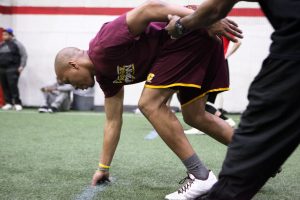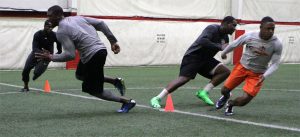Coaches are constantly asking me for speed & agility tips to make their programs more effective. After talking with hundreds of coaches and looking at what is happening all over the country, I have come up with six keys to increasing the effectiveness of any speed & agility program. Here are the 6 simple speed & agility tips:
1. Educate the athletes. If your athletes don’t have an understanding of why they are doing a drill, there is a good chance they are thinking of it as torture or punishment. It is up to you to explain the purpose of a drill so the athletes fully understand how it impacts performance. Typically, this will motivate an athlete to work harder because they will understand how their hard work will pay off in the game. It also helps you, the coach, to choose drills that will actually benefit the athletes. If you don’t have a clear understanding of the purpose of a drill, you’re probably missing something.
I can’t tell you how often I see coaches lining up cones, ladders and boxes in the name of speed and agility training, but the movements used in the drills have absolutely nothing to do with the movements used in the sport. If you have to explain how it will help the athlete, you are more likely to choose appropriate drills.
2. Focus on mechanics. Allowing your athletes to do drills with faulty movement patterns is  like a golf pro watching his student hit ball
like a golf pro watching his student hit ball
after ball with terrible flaws in his swing, and never providing any corrective feedback. Athletes practice sport skills and play games all the time, but they are rarely taught how to move properly; they are just expected to know how. But, if a kid has never been shown how to do something, how can you expect him/her to do it correctly?
Of all the speed & agility tips listed in this article, this may be the most important.
It is up to you to teach your athletes some of the most basic movement concepts in sports – running, cutting, shuffling, pivoting, jumping, etc. Athletes are not learning this anywhere else, so it is up to us to teach them these valuable movement skills. This is exactly what the IYCA Certified Speed & Agility Specialist (CSAS) course teaches, which is why it is such an important course for anyone working with athletes.
Begin by teaching them like they have never performed these movements in their lives. In my writing and seminars, I refer to this as Movement Training, and by implementing Movement Training concepts into your speed training program your athletes will always end up farther ahead.
3. Quality not quantity. Too often, SAQ workouts turn into conditioning sessions. Remember, the goal is improving speed and agility, not aerobic fitness. Keep the work periods short and the rest periods long so the athletes can give 100% effort on each drill. You are trying to teach the nervous system how to work more efficiently, so the athletes need to be fresh. If the rest periods are too short, the work periods too long, or the athletes are simply fatigued from previous work, mechanics will disintegrate and the same old faulty movement patterns will ultimately be reinforced.
For optimal speed development results, keep the work periods to 2-10 seconds and the rest periods as long as 20-60 seconds or even longer if the intensity is extremely high. Explain that you will be giving long rest periods so the drills can be done with maximum intensity, and stick to your word.
4. Sport specificity. As long as you are trying to teach your athletes to move more efficiently, it makes sense to practice movements that will actually be used in a game. Sprinting and cutting are used in just about every sport, but don’t forget about the very specific skills your athletes need to perform on the field or court. These movements include shuffling, stopping, pivoting, faking, spinning, cross-over running, backpedaling, etc.
As much as possible, include these movements into your SAQ sessions. Baseball and softball  players should practice starting sprints like they are stealing a base. Volleyball players should incorporate lunging, approach steps and jumps into their drills. Football receivers should practice their routes. Quarterbacks should incorporate drop steps and linemen should start drills from 2-, 3-, or 4-point starting positions. Use your imagination to create drills that mimic competition.
players should practice starting sprints like they are stealing a base. Volleyball players should incorporate lunging, approach steps and jumps into their drills. Football receivers should practice their routes. Quarterbacks should incorporate drop steps and linemen should start drills from 2-, 3-, or 4-point starting positions. Use your imagination to create drills that mimic competition.
Ladder drills and plyos are great general training methods, but if you don’t make your athletes practice their most important movements you should never wonder why they don’t perform them well in a game.
5. Consistency. As I stated earlier, SAQ programs are meant to train the nervous system. The best way to make this happen is to consistently practice sport specific skills so the nervous system learns the optimal movement patterns. 5-20 minutes, 2-3 days per week is all it takes.
You can make this happen by adding two short drills to your warm-up routine, or including one or two sport-specific drills into the beginning of each strength training session. This does not mean strength movements that “resemble” the sport movements – I’m talking about actually doing a couple of sprints or agility drills before each workout. As long as technique is emphasized, this brief, consistent practice will add up and allow your athletes to perform these skills perfectly on the field or court without any thought. You basically have to take the other five speed & agility tips listed here, and apply them consistently to get the best results.
6. Long-term development. Another major problem I see in a lot of SAQ programs is implementing them a few weeks before the season, hoping for a miracle. Starting these drills 2-3 weeks before your first game is simply too late for major benefits to be seen. Unfortunately, many coaches hope that a few simple speed & agility tips will work like magic. That’s not how athletic development works, so make sure you have enough time to make a real impact.
You will certainly see benefits from doing SAQ drills during your pre-season, but working the drills into your year-round training program will elicit maximum results. Pre-season training should focus on technical/tactical skills and conditioning. Too often, though, I see coaches conditioning the athletes during the off-season; this is a waste of time and energy. If you have contact with your athletes during the off-season, work on strength, movement training and technical skill development for the greatest long-term results.
If you can teach your freshmen how to move, and include a few minutes of practice before every strength training session, imagine what a difference that will make by the time they are juniors and seniors. It’s never too early to teach kids how to move. Don’t wait until it’s too late.
Introduce changes gradually, and continually attempt to make improvements. Speed and agility training will have a positive impact on any team, and incorporating these six keys will help you run the most effective program possible.
I hope these 6 speed & agility tips help you create more effective programs that will make a bigger impact on them.
Click on the image below to learn more about the IYCA Certified Speed & Agility Specialist course, the most comprehensive, and scientifically sound speed & agility certification in the industry.


